ISSN ONLINE(2278-8875) PRINT (2320-3765)
ISSN ONLINE(2278-8875) PRINT (2320-3765)
M.Sharmila1, Ms.V.Mangaiyarkarasi2
|
| Related article at Pubmed, Scholar Google |
Visit for more related articles at International Journal of Advanced Research in Electrical, Electronics and Instrumentation Engineering
Distillation is a continuous process in the petroleum and the chemical industries. A high amount of energy used in the chemical and petrochemical industries is consumed in the distillation process, since large amount of heat transfer takes place between the trays of distillation column. Thus, there is a need of energy efficient process to be designed and controlled, in order to make the final and the intermediate products of the distillation process of desired quality and the whole process being more economic. In the present study, graphical programming of LabVIEW software has been utilized to develop model for distillation column and also to control the product stream composition. Results from the simulation are helpful for initial steps of a petroleum project feasibility study and design
Keywords |
| Modeling, Binary Distillation Column, Controllers, Simulation. |
INTRODUCTION |
| Distillation column plays a important role in petro -chemical and refinery industries. Distillation is a process in which a liquid or vapour mixture of two or more substances is separated into its component fractions of desired purity, by the application and removal of heat. Binary distillation column is used to separate two components (Component A & component B) . Example for Binary mixture is methanol and water. Fig 1.1 shows the schematic diagram of distillation column. Distillation column generally made up of tray of tower/column. Tray types have more efficient than other type. The distillation column consists of many trays, condenser, reboiler, and a vertical column for the separation purpose. In this paper, distillation is a continuous process. It means that the feed is given in continuous manner. Here feed is the input to the column. Distillation column is separated into two sections. They are stripping section and rectification section. The trays above the feed tray is called stripping section. |
| The binary mixture is fed into the feed tray with flow rate Ff and a molar fraction of component A, Cf. The overhead product is completely condensed using condenser and it is allowed to flow in the reflux drum. The liquid in the reflux drum partly pumped back to the top tray FR and it is partially removed as distillate product with molar flow rate of FD . let us consider MRD is the liquid hold up in the reflux drum and XD is the molar fraction of component A of liquid in the reflux drum. At the bottom of the column , a liquid stream is removed with flow rate of FB and composition of XB . A liquid stream with molar flow rate of v is also drawn from the bottom of the column and after that it has been heated in the reboiler, it returns back to the base of the column. The composition of the column base is XB. Let MB is the liquid holdup in the base of the column. The column contains N trays numbered from bottom of the column to top of the column. |
 |
| Distillation column, as described earlier is a long tower comprising of several components, which are responsible for the energy and mass transfer, such as |
| (i) the simple vapour liquid equilibrium is used, |
 |
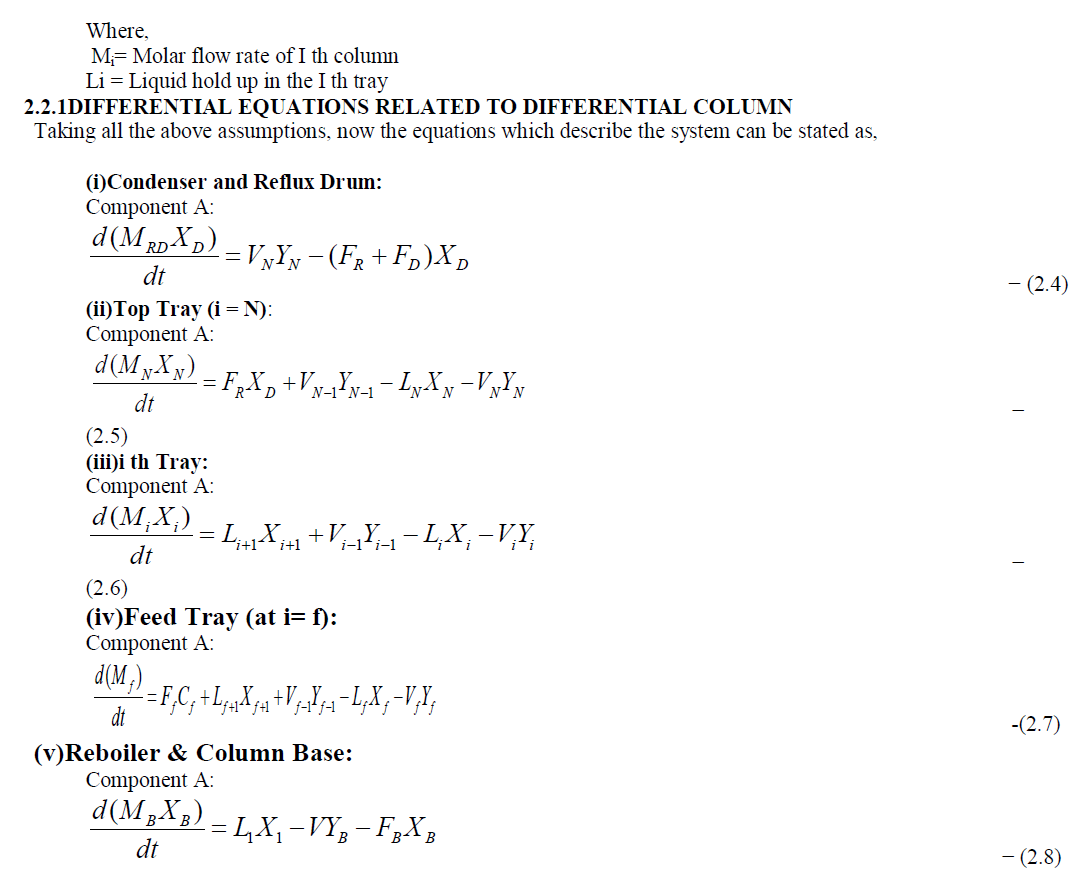 |
| Based on equations 2.1-2.8, the mathematical model of the distillation column has been designed in the LabVIEW. Top product (Distillate) composition and the bottom product composition are the output i.e. Controlled variables of the plant system, and the manipulate variables are the Reflux Rate (L) and the Vapour Boilup Rate (V). |
MODEL PARAMETERS AND NOMINAL OPERATING POINT |
| The values of the model parameters used in this dissertation are as follows in table 2.1, [4] Table 2.1. Distillation Column Model Parameters. |
 |
III. CONTROLLER |
| A controller generates the control signal based on the control strategy employed and the input variable. The input variable to a controller is the error i.e. difference between the reference input and output. In this paper, it deals with feedback controller such as, P, PI, PID controllers are used to obtain the desire quality of distillate and bottom products. |
IV. SIMULATION DIAGRAM |
| Different parts/subsystems and their block diagram programming, are as following, |
4.1 I th TRAY |
| The equation of the nth tray has two inputs i.e. xi+1 and xi-1 and one output i.e. xi.. In addition to that a vapour liquid equilibrium has also been used to calculate the value of yi. This value of yi is being used to solve equation further. Fig 4.1 shows the block diagram of I th tray. |
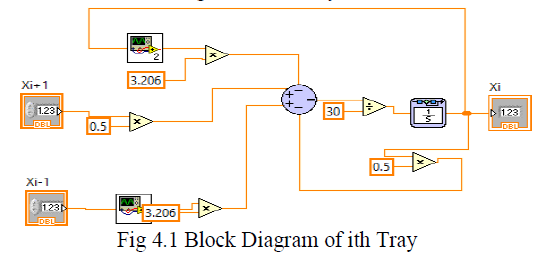 |
4.2 FEED TRAYF |
| The equation of the Feed tray has four inputs i.e. xi+1 , xi-1, xf and zf and one output .Fig 4.2 shows the block diagramof feed tray. |
 |
4.3 CONDENSER AND REFLUX DRUM |
| The equation for the condenser and reflux drum are not iterative, hence it is not made as subsystem and are used directly in the block diagram. Fig 4.3 shows the block diagram of reflux drum. |
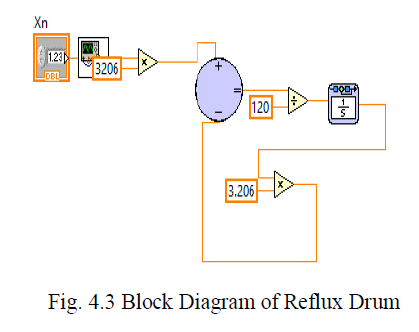 |
V. RESULT AND DISCUSSION |
| The model for Distillation Column is linearized around the point [99.25%, .10%] i.e. the distillate composition and the bottom product composition respectively. A step change of magnitude [.5 %] in the composition has been fed to the system and the variation in the composition of the top and the bottom product has been analyzed. Different combinations of the values for Kp, TI, TD has been used to observe the variation of the composition of the products and the variations are showed in fig 5.1 - fig 5.3 . |
5.1 CONTROL STRATEGIES |
| Case 1: Simple Proportional Controller: |
| KP1 = 49.095,KP2 = 32.183 |
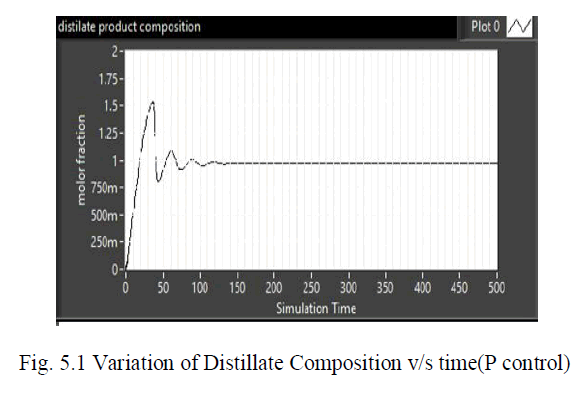 |
| Case 2: Proportional Integral Control: |
| KP1 = 24.7486 Ti 1 = 9.24609,KP2 = 28.1027 Ti 2 = 7.3494 |
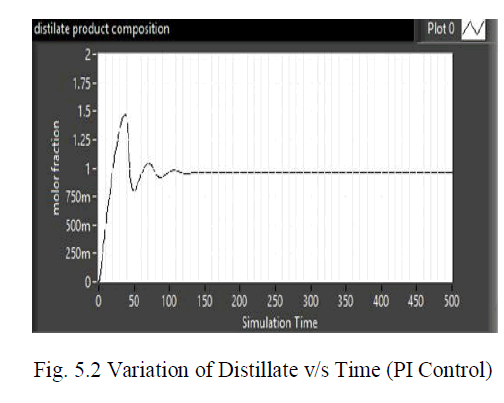 |
| Case 3: Proportional Integral Derivative Control: |
| KP1 = 15.3594 Ti 1 = 6.54891 Td 1 = .1891 |
| KP2 = 21.848 Ti 2 = 4.363 Td 1 = .1857 |
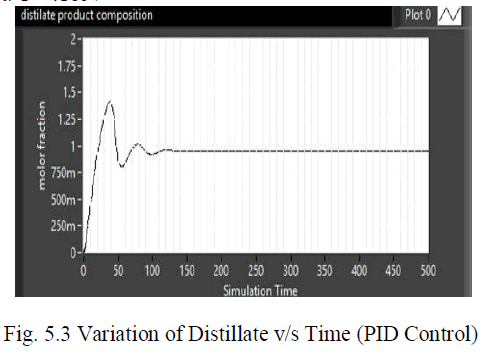 |
| Case I: In this strategy only proportional controller is applied and the Steady state error found to be very large, thus the controller was not acceptable. |
| Case II: In this a PI controller is employed, although steady state error came down as integral controller has been added, but the Settling time and overshoot are still not acceptable, thus the PI controller with the said values of parameters is not acceptable. |
| Case III: In this case, PID controller with tight tuning of the parameters is used. Steady state error has been removed by application of the integral controller and the transient response has been improved with the application of the derivative controller and the peak overshoot will be reduced.The output response has less oscillation. it can be acceptable. |
VI. CONCLUSION |
| The procedure has been introduced to build up a mathematical model and simulation for a binary distillation column based on the energy balance (L-V) equations. By comparing the simulation results of various controllers, PID controller can be acceptable, since the Steady state error has been removed by application of the integral controller and the transient response has been improved with the application of the derivative controller. Hence PID controller is better than other to obtain the desire distillate product. |
References |
|